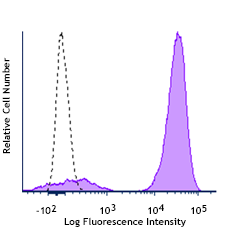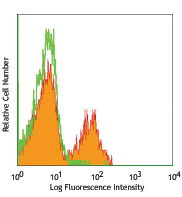- Regulatory Status
- RUO
- Other Names
- Streptavidin-Phycoerythrin, SAv-PE
- Ave. Rating
- Submit a Review
- Product Citations
- publications

-

C57BL/6 splenocytes stained with 145-2C11 biotin, followed by SAV-PE
| Cat # | Size | Price | Quantity Check Availability | Save | ||
|---|---|---|---|---|---|---|
| 405203 | 100 µg | £39 | ||||
| 405204 | 500 µg | £134 | ||||
Streptavidin binds to biotin with high affinity. Streptavidin-Phycoerythrin (PE) is useful for detecting biotinylated antibodies. The excitation of PE by 488 nm laser light induces a light emission maximum of 575 nm.
Product DetailsProduct Details
- Verified Reactivity
- Human, Mouse, Rat, All Species
- Formulation
- Phosphate-buffered solution, pH 7.2, containing 0.09% sodium azide.
- Preparation
- Streptavidin is conjugated with PE under optimal conditions.
- Concentration
- 0.2 mg/ml (concentration relates to the Streptavidin only component of the conjugate)
- Storage & Handling
- The streptavidin-PE solution should be stored undiluted between 2°C and 8°C, and protected from exposure to light. Do not freeze.
- Application
-
FC - Quality tested
ICFC - Verified
- Recommended Usage
-
This streptavidin product is quality control tested by immunofluorescent staining with flow cytometric analysis. The concentration provided is based upon molecular mass of streptavidin independent of any additional molecular mass that might be added by the PE conjugation. For flow cytometric staining, the suggested use of this reagent is ≤0.06 µg per million cells in 100 µl volume. It is recommended that the reagent be titrated for optimal performance for each application.
- Excitation Laser
-
Blue Laser (488 nm)
Green Laser (532 nm)/Yellow-Green Laser (561 nm)
- Application Notes
-
Streptavidin-Phycoerythrin (PE) is useful as a second step reagent for indirect immunofluorescent staining, when used in conjunction with biotinylated primary antibodies. The average molecular weight of Streptavidin-PE is 360 kD and Streptavidin alone is 52 kD.
-
Application References
(PubMed link indicates BioLegend citation) -
- Chappaz S, et al. 2007. Blood doi:10.1182/blood-2007-02-074245.
- Nishimoto KP,et al. 2008. J. Immunol. 181:4010.PubMed
- Niki T, et al. 2009. J. Biol. Chem. 284:32344. PubMed
- Shibui A, et al. 2011. Exp Parasitol. 129:318. PubMed
- Scatizzi JC, et al. 2012. J. Immunol. 188:3307. PubMed
- Yamakawa N, et al. 2012. Int Immunol. 25:45. PubMed
- Shibata T, et al. 2012. Int Immunol. 24:613. PubMed
- Baccala R, et al. 2012. J. Immunol. 189:5976. PubMed
- Grevers LC, et al. 2013. Ann Reheum Dis. 72:278. PubMed
- Woo SJ, et al. 2013. J Leukoc Biol. 93:363. PubMed
- Ashbaugh JJ, et al. 2013. J. Immunol. 190:4525. PubMed
- Reading JL, 2013. J. immunol. 190:4542. Pubmed.
- Kanno A, et al. 2013. Int Immunol. 25:413. PubMed
- Gunaydin G, et al. 2014. Vaccine. 32:470. PubMed
- Lyngaa R, et al. 2014. Clin Cancer Res. 20:1768. PubMed
- Datta S, et al. 2014. J Leukoc Biol. 95:853. PubMed
- He X, et al. 2014. J Immunol. 193:1314. PubMed
- Wang W, et al. 2014. PNAS. 111:14466. PubMed
- Murakami Y, et al. 2014. J Immunol. 193:5208. PubMed
- Lucas A, et al. 2015. PLoS One. 10:117160. PubMed
- Kim Yu, et al. 2015. PLoS One. 10:120294. PubMed
- Hua X, et al. 2015. PloS One. 10:128039. PubMed
- Product Citations
-
Antigen Details
- Gene ID
- NA
- UniProt
- View information about Biotin on UniProt.org
Related Pages & Pathways
Pages
Related FAQs
- What type of PE do you use in your conjugates?
- We use R-PE in our conjugates.
 Login / Register
Login / Register 

















Follow Us